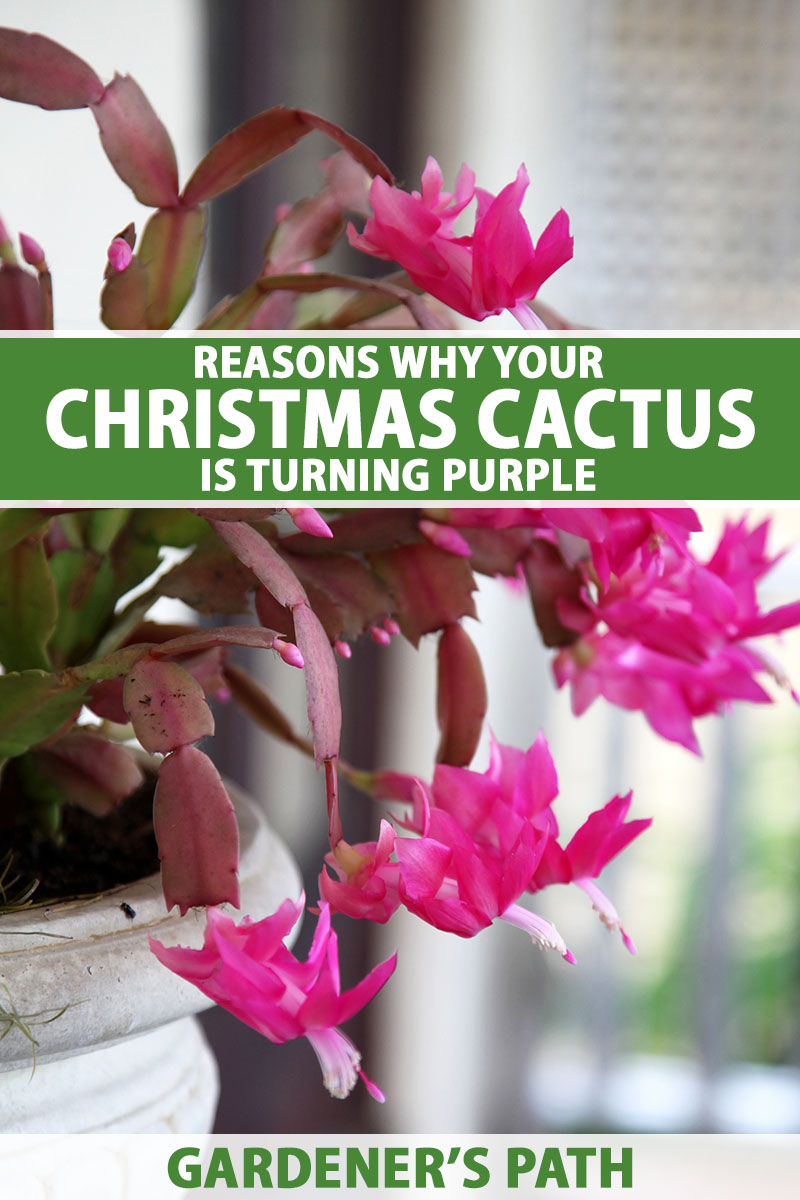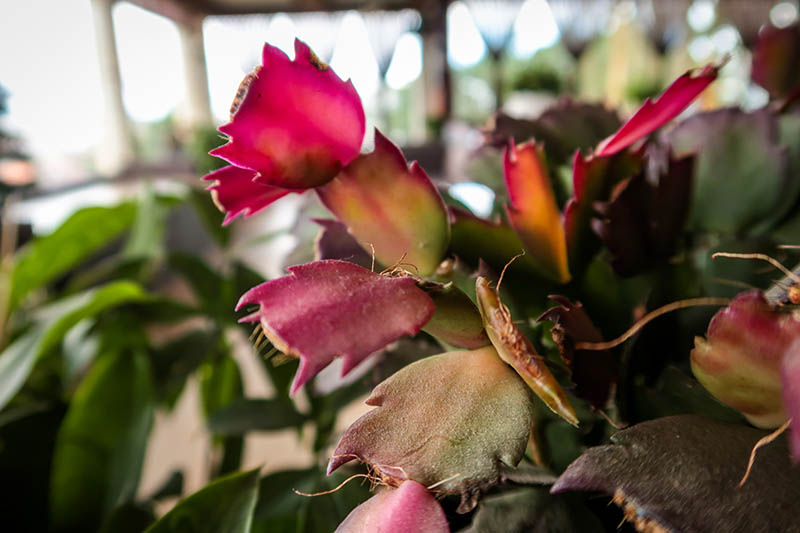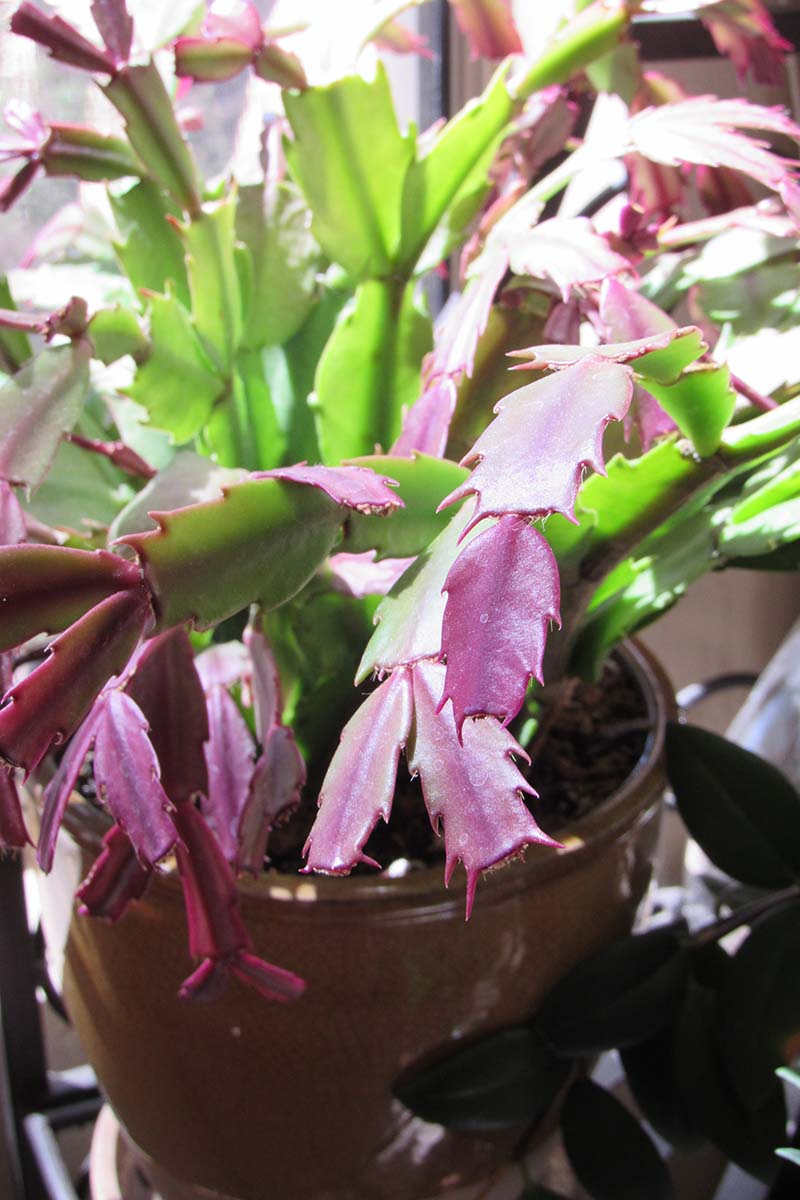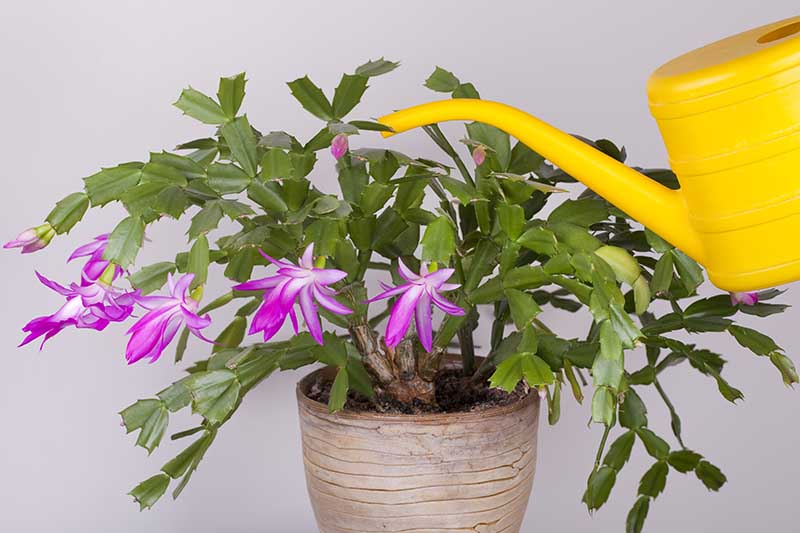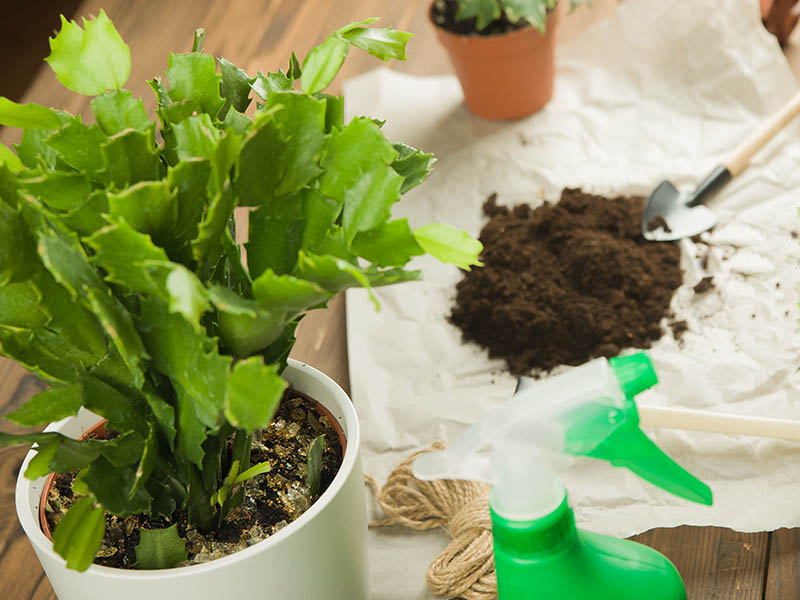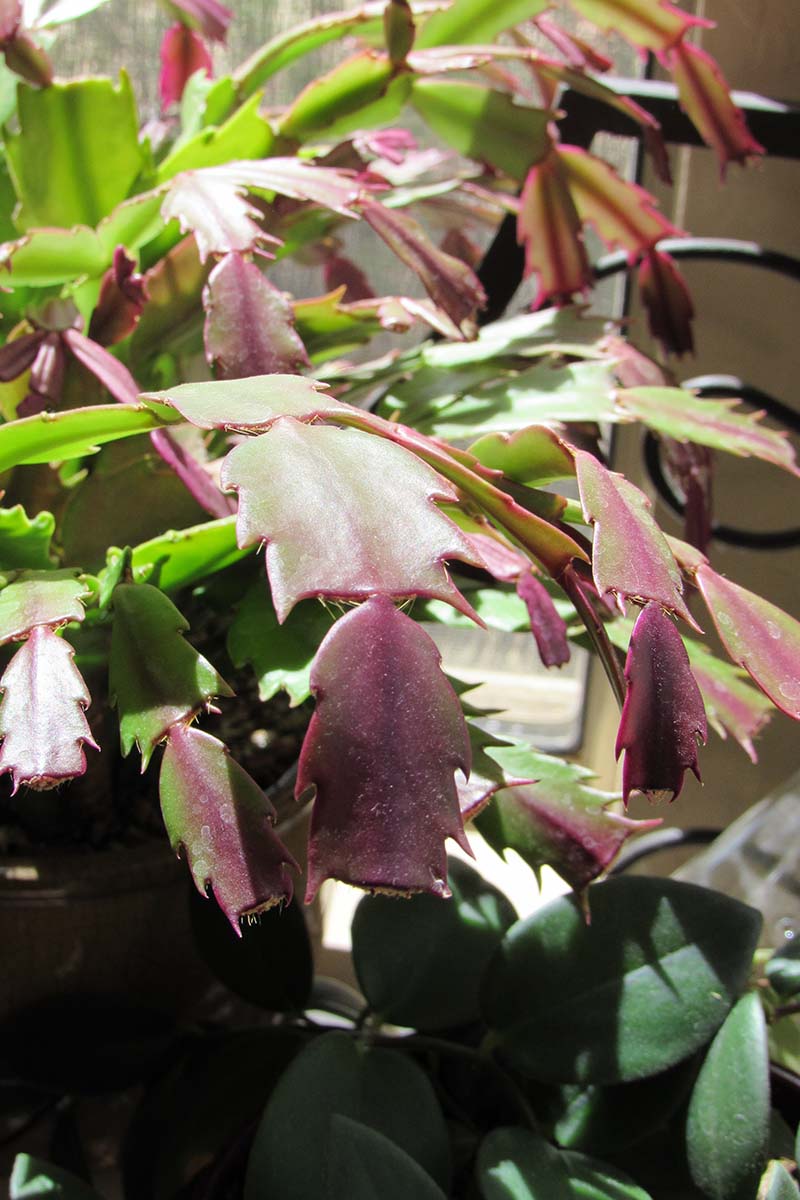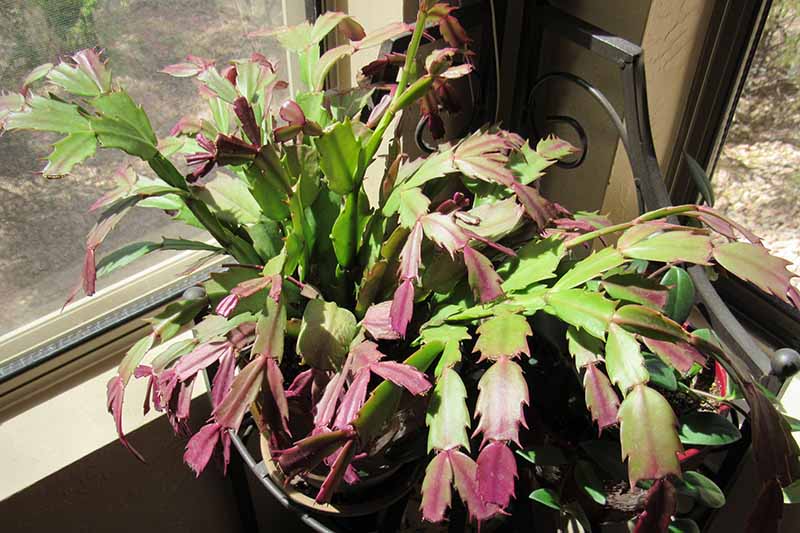Not a desert cactus, but an epiphyte, it is one of a number of species and hybrids of rainforest plants that cling harmlessly to trees and rocks for support, drawing sustenance from the air, rainfall, and leaf litter in their immediate environment. In our guide to growing Christmas cactus, we share insight on best practices for cultivation. We link to vendors to help you find relevant products. If you buy from one of our links, we may earn a commission. Here’s what’s in store:
Is Your Christmas Cactus Stressed?
Plants may not be able to speak, but they can still communicate with us, and let us know they are stressed. One way a Christmas cactus lets us know it’s in trouble is by putting out thread-like aerial roots from between the stem segments.
You can learn more about why Christmas cactus develops hair-like roots in our guide. Another is for the stem segments to morph from their natural vibrant green to shades of purple, including red and pink, in response to stressful environmental conditions. The four most likely reasons for purple-hued discoloration are: bright light, inappropriate moisture, nutrient deficiency, and extreme temperature fluctuations. Let’s consider these stressors and how to avoid them.
Bright Light
A likely reason for purple coloration is exposure to bright, direct sunlight. When a plant is genetically wired to grow in the sun-dappled shade of a rainforest canopy, an overabundance of light may trigger a protection response to the ultraviolet (UV) rays.
Instead of presenting with chlorophyll-rich green stems, the life-threatening bright light induces UV protective phenolic compounds called anthocyanins to dominate with their purple pigment. A Schlumbergera that is left to contend with excessive sunlight will likely scorch, which can damage stem tissue beyond repair. This damage prevents it from absorbing sunlight, and jeopardizing photosynthesis, the conversion of sunlight to food. Avoid this issue by choosing a location with indirect, or filtered sunlight, preferably facing north or west.
Inappropriate Moisture
Failing to accommodate the need for water may cause stress-induced color changes. Both under- and overwatering may be culprits.
Underwatering
An underwatered plant may turn purple before drying to a brittle, lifeless brown. Water is as essential as sunlight, and a lack of adequate moisture inhibits photosynthesis. Additionally, a very dry environment can cause the plant to become stressed.
If you find that your home is dry during the winter, place a shallow pan of water in front of a heat register and sanitize it whenever it dries up. As the water evaporates, it adds moisture and humidity to the air. Another evaporation method is to place your potted cactus on a bed of gravel in a shallow pan. Add enough water to cover the gravel. You can also group houseplants together, and mist them occasionally to replicate the tropical moisture to which rainforest cacti are accustomed.
Overwatering
The flip side, overwatering, may cause leaves to yellow, and in extreme cases, take on a purple to brown cast before turning mushy. Severe over- or underwatering may extend all the way to the roots. Air is another photosynthesis essential. When roots are waterlogged, they cannot breathe, posing a deadly challenge to the food production process. To prevent moisture-related stress, use a pot with an ample drainage hole. Use a potting medium that is loose and well-draining. Learn more about the right potting mix for your Christmas cactus in our guide. Water only when the top one to two inches of potting medium feel dry. If you’ve oversaturated your plant, you may be able to dry things out by digging the cactus up, rinsing its roots, cutting off any rotten patches, and repotting it in lightly moistened medium. As a last resort, if the plant is severely damaged, you may be able to salvage at least a bit of stem segment or root that haven’t rotted, to propagate a whole new cactus. Find more tips on saving an overwatered Christmas cactus here.
Nutrient Deficiency
And finally, your plant’s purple phase may be the result of a deficiency in one or more essential macronutrients, including magnesium, nitrogen, and phosphorus.
Malnutrition may occur because of:
Poor quality potting medium from the start Nutritionally depleted potting medium due to years of use An extremely tight tangle of roots that can’t take up nutrients from the potting medium Root damage from transplanting, accidental damage, pests or disease, or improper watering
To remedy nutrient deficiencies, use a quality potting medium and repot as needed in a slightly larger pot, as Schlumbergera prefers a snug, but not densely rootbound fit. Some folks apply a highly diluted Epsom salts solution (one teaspoon per gallon of water), but this presumes that the deficiency is magnesium. You can give this a try, but if it doesn’t work, apply a well-balanced, slow-release all-purpose houseplant fertilizer to address all potential macronutrient deficiencies. Be sure to water properly, and watch for signs of insect infestation or growth anomalies that may suggest disease.
Temperature Extremes
The excessive heat associated with bright direct sunlight is a contributing factor to reactive discoloration, as a plant attempts to protect itself from the stressful climate condition.
Similarly, cold temperatures may invite the same response, just like we see on outdoor perennials that have experienced chilling temperatures, but not a decimating frost. To avoid temperature-induced discoloration, keep your cactus in a room with a temperature range of 70 to 80°F. A short-term change in temperature is necessary during dormancy, to prepare a plant for blooming, which you can learn more about in our guide to encouraging your Christmas cactus to flower. This requires six to eight weeks of 50 to 55°F temperatures, and long dark nights that mimic a natural winter. Minimize temperature fluctuations by placing your pot in a location away from drafts from windows, heat registers, and exit doors. Shading to purple provides a visual cue that something is amiss. If you see this, examine your gardening practices and the indoor environment for the following:
Light that is too intense. Too much or too little moisture. Depleted soil or extremely bound roots. Temperatures that overheat or chill.
Listen to your plant’s cry for help and act quickly. Unless the effects of the stressors have progressed to desiccation or rotting, you can usually restore a cactus with a change of location and/or more vigilant care.
If it’s too far gone, you may be able to find a healthy bit of stem or root to snip off and use to propagate a whole new plant. Cultivating Christmas cactus is easy when you “listen” and respond. Has your Christmas cactus ever turned purple? Let us know in the comments below and share your tips! If you found this article informative and want to expand your knowledge of houseplant care, check out the following guides next:
How to Grow and Care for Amaryllis Flowers How to Grow and Care for Peace Lily How to Grow and Care for Poinsettia Plants
© Ask the Experts, LLC. ALL RIGHTS RESERVED. See our TOS for more details. Uncredited photos: Shutterstock.

